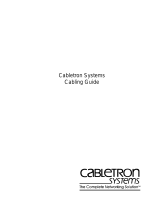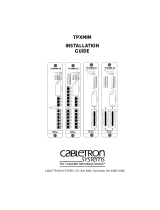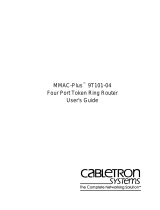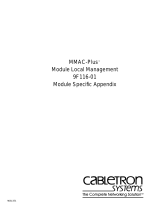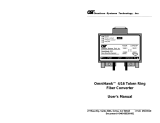Page is loading ...

EMM-E6
USER’S
GUIDE
EMM-E6
ETHERNET
EPIM-A
PWR
STBY
RCV
XMT
CLN
D C B A
CPU
RESET
SN
E
P
I
M
1
E
P
I
M
2
C
O
M
1
C
O
M
2
F
E
EPIM-A
PWR
LNK YEL STB DSR LNK
T1/FT1
TST RED SYN CTS TST
SYNC
BRIM-WT1
BRIM-A100
STY
LNK
XMT
RCV
BRIM-F6
CABLETRON SYSTEMS, P.O. Box 5005, Rochester, NH 83866-5005
CH1Book Page 1 Wednesday, March 20, 1996 7:48 AM

EMM-E6 User’s Guide
i
NOTICE
Cabletron Systems reserves the right to make changes in specifications
and other information contained in this document without prior notice.
The reader should in all cases consult Cabletron Systems to determine
whether any such changes have been made.
The hardware, firmware, or software described in this manual is subject to
change without notice.
IN NO EVENT SHALL CABLETRON SYSTEMS BE LIABLE FOR
ANY INCIDENTAL, INDIRECT, SPECIAL, OR CONSEQUENTIAL
DAMAGES WHATSOEVER (INCLUDING BUT NOT LIMITED TO
LOST PROFITS) ARISING OUT OF OR RELATED TO THIS
MANUAL OR THE INFORMATION CONTAINED IN IT, EVEN IF
CABLETRON SYSTEMS HAS BEEN ADVISED OF, KNOWN, OR
SHOULD HAVE KNOWN, THE POSSIBILITY OF SUCH DAMAGES.
Copyright July 1995 by:
Cabletron Systems, Inc., P.O. Box 5005, Rochester, NH 03866-5005
All Rights Reserved
Printed in the United States of America
Part Number: 9031515 July 1995
LANVIEW
and
SPECTRUM
are registered trademarks, and
ESXMIM,
ESXMIM-F2, EMM-E6, EMME, IRM
,
MMAC
,
TPMIM, TPRMIM,
THN-MIM, CXRMIM, FOMIM, FORMIM, TPXMIM, TPT, FOT-F,
TMS-3, LANVIEW
SECURE
, BRIM, FPIM, APIM,
and
EPIM
are
trademarks of Cabletron Systems, Inc.
Windows
is a registered trademark of Microsoft Corp.
VT220
,
VT320, VT100
and
DECNet
are trademarks of Digital
Equipment Corp.
i960
is a trademark of Intel Corp.
AppleTalk
is a registered trademark of Apple Computer, Inc.
Ethernet
is a trademark of Xerox Corp.
CompuServe
is a registered trademark of CompuServe, Inc.
Printed on recycled paper.
CH1Book Page i Wednesday, March 20, 1996 7:48 AM

NOTICE
ii EMM-E6 User’s Guide
FCC NOTICE
This device complies with Part 15 of the FCC rules. Operation is subject
to the following two conditions: (1) this device may not cause harmful
interference, and (2) this device must accept any interference received,
including interference that may cause undesired operation.
NOTE:
This equipment has been tested and found to comply with the
limits for a Class A digital device, pursuant to Part 15 of the FCC rules.
These limits are designed to provide reasonable protection against
harmful interference when the equipment is operated in a commercial
environment. This equipment uses, generates, and can radiate radio
frequency energy and if not installed in accordance with the operator’s
manual, may cause harmful interference to radio communications.
Operation of this equipment in a residential area is likely to cause
interference in which case the user will be required to correct the
interference at his own expense.
WARNING:
Changes or modifications made to this device which are not
expressly approved by the party responsible for compliance could void
the user’s authority to operate the equipment.
DOC NOTICE
This digital apparatus does not exceed the Class A limits for radio noise
emissions from digital apparatus set out in the Radio Interference
Regulations of the Canadian Department of Communications.
Le présent appareil numérique n’émet pas de bruits radioélectriques
dépassant les limites applicables aux appareils numériques de la class A
prescrites dans le Règlement sur le brouillage radioélectrique édicté par le
ministère des Communications du Canada.
CH1Book Page ii Wednesday, March 20, 1996 7:48 AM

NOTICE
EMM-E6 User’s Guide iii
VCCI NOTICE
This equipment is in the Class I Category (information equipment to be
used in commercial and/or industrial areas) and conforms to the standards
set by the Voluntary Control Council for Interference by Information
Technology Equipment (VCCI) aimed at preventing radio interference in
commercial and/or industrial areas.
Consequently, when used in a residential area or in an adjacent area
thereto, radio interference may be caused to radios and TV receivers, etc.
Read the instructions for correct handling.
CABLETRON SYSTEMS, INC.
PROGRAM LICENSE AGREEMENT
IMPORTANT:
Before utilizing this product, carefully read this
License Agreement.
This document is an agreement between you, the end user, and Cabletron
Systems, Inc. (“Cabletron”) that sets forth your rights and obligations
with respect to the Cabletron software program (the “Program”)
contained in this package. The Program may be contained in firmware,
chips or other media. BY UTILIZING THE ENCLOSED PRODUCT,
YOU ARE AGREEING TO BECOME BOUND BY THE TERMS OF
THIS AGREEMENT, WHICH INCLUDES THE LICENSE AND THE
LIMITATION OF WARRANTY AND DISCLAIMER OF LIABILITY.
IF YOU DO NOT AGREE TO THE TERMS OF THIS AGREEMENT,
PROMPTLY RETURN THE UNUSED PRODUCT TO THE PLACE OF
PURCHASE FOR A FULL REFUND.
CH1Book Page iii Wednesday, March 20, 1996 7:48 AM

NOTICE
iv EMM-E6 User’s Guide
CABLETRON SOFTWARE PROGRAM LICENSE
1. LICENSE. You have the right to use only the one (1) copy of the
Program provided in this package subject to the terms and conditions
of this License Agreement.
You may not copy, reproduce or transmit any part of the Program
except as permitted by the Copyright Act of the United States or as
authorized in writing by Cabletron.
2. O
THER RESTRICTIONS. You may not reverse engineer,
decompile, or disassemble the Program.
3. APPLICABLE LA
W. This License Agreement shall be interpreted
and governed under the laws and in the state and federal courts of
New Hampshire. You accept the personal jurisdiction and venue of
the New Hampshire courts.
BELLCORE TESTING INFORMATION
This product has been tested by Bellcore and found to comply with the
following Bellcore Standards:
1. TR-NWT-000063: Network Equipment Building System (NEBS)
Generic Equipment Requirements
2. GR-1089-CORE: EMC and Electrical Safety Generic Criteria for
Network Telecommunications Equipment.
CH1Book Page iv Wednesday, March 20, 1996 7:48 AM

NOTICE
EMM-E6 User’s Guide v
EXCLUSION OF WARRANTY AND
DISCLAIMER OF LIABILITY
1. EXCLUSION OF WARRANTY. Except as may be specifically
provided by Cabletron in writing, Cabletron makes no warranty,
expressed or implied, concerning the Program (including Its
documentation and media).
CABLETRON DISCLAIMS ALL WARRANTIES, OTHER THAN
THOSE SUPPLIED TO YOU BY CABLETRON IN WRITING,
EITHER EXPRESS OR IMPLIED, INCLUDING BUT NOT
LIMITED TO IMPLIED WARRANTIES OF MERCHANTABILITY
AND FITNESS FOR A PARTICULAR PURPOSE, WITH
RESPECT TO THE PROGRAM, THE ACCOMPANYING
WRITTEN MATERIALS, AND ANY ACCOMPANYING
HARDWARE.
2. NO LIABILITY FOR CONSEQ
UENTIAL DAMAGES. IN NO
EVENT SHALL CABLETRON OR ITS SUPPLIERS BE LIABLE
FOR ANY DAMAGES WHATSOEVER (INCLUDING, WITHOUT
LIMITATION, DAMAGES FOR LOSS OF BUSINESS, PROFITS,
BUSINESS INTERRUPTION, LOSS OF BUSINESS
INFORMATION, SPECIAL, INCIDENTAL, CONSEQUENTIAL,
OR RELIANCE DAMAGES, OR OTHER LOSS) ARISING OUT
OF THE USE OR INABILITY TO USE THIS CABLETRON
PRODUCT, EVEN IF CABLETRON HAS BEEN ADVISED OF
THE POSSIBILITY OF SUCH DAMAGES. BECAUSE SOME
STATES DO NOT ALLOW THE EXCLUSION OR LIMITATION
OF LIABILITY FOR CONSEQUENTIAL OR INCIDENTAL
DAMAGES, OR ON THE DURATION OR LIMITATION OF
IMPLIED WARRANTEES, IN SOME INSTANCES THE ABOVE
LIMITATIONS AND EXCLUSIONS MAY NOT APPLY TO YOU.
CH1Book Page v Wednesday, March 20, 1996 7:48 AM

NOTICE
vi EMM-E6 User’s Guide
UNITED STATES GOVERNMENT RESTRICTED RIGHTS
The enclosed product (a) was developed solely at private expense; (b)
contains “restricted computer software” submitted with restricted rights in
accordance with Section 52227-19 (a) through (d) of the Commercial
Computer Software - Restricted Rights Clause and its successors, and (c)
in all respects is proprietary data belonging to Cabletron and/or its
suppliers.
For Department of Defense units, the product is licensed with “Restricted
Rights” as defined in the DoD Supplement to the Federal Acquisition
Regulations, Section 52.227-7013 (c) (1) (ii) and its successors, and use,
duplication, disclosure by the Government is subject to restrictions as set
forth in subparagraph (c) (1) (ii) of the Rights in Technical Data and
Computer Software clause at 252.227-7013. Cabletron Systems, Inc., 35
Industrial Way, Rochester, New Hampshire 03867.
CH1Book Page vi Wednesday, March 20, 1996 7:48 AM

EMM-E6 User’s Guide vii
TABLE OF CONTENTS
CHAPTER 1 INTRODUCTION
1.1 USING THIS MANUAL........................................................1-1
1.2 EMM-E6 FEATURES..........................................................1-4
1.3 THE MMAC WITH FLEXIBLE NETWORK BUS .................1-10
1.4 ETHERNET CHANNELS A, B, C, D, E, and F....................1-12
1.4.1 Ethernet Channel A................................................1-12
1.4.2 Ethernet Channels B and C....................................1-13
1.4.3 Other FNB Modules................................................1-14
1.4.4 Ethernet Channel D................................................1-15
1.5 CHANNELS E AND F..........................................................1-16
1.6 BRIDGES............................................................................1-17
1.6.1 Filtering and Forwarding.........................................1-18
1.6.2 Spanning Tree Algorithm........................................1-19
1.7 LOCAL MANAGEMENT FEATURES..................................1-20
1.8 COMMUNITY NAMES ........................................................1-21
1.9 SNMP..................................................................................1-21
1.9.1 MIBs.......................................................................1-22
1.10 REVIEW OF ADDRESSING ...............................................1-22
1.10.1 MAC Addresses .....................................................1-22
1.10.2 IP Addresses..........................................................1-23
1.10.3 Identifying IP Address Classes...............................1-25
1.10.4 Subnet Addresses..................................................1-25
1.10.5 Subnet Masks.........................................................1-26
1.10.6 Operation of the Subnet Mask................................1-30
1.10.7 Default Gateway.....................................................1-30
1.10.8 Addressing Example ..............................................1-31
1.11 LANVIEW LEDs AND RESET SWITCH..............................1-33
1.12 LANVIEWSECURE.............................................................1-33
1.13 GETTING HELP..................................................................1-35
1.14 RELATED MANUALS .........................................................1-35
CH1Book Page vii Wednesday, March 20, 1996 7:48 AM

TABLE OF CONTENTS
viii EMME-E6 User’s Guide
CHAPTER 2 REQUIREMENTS / CONFIGURATIONS
2.1 NETWORK REQUIREMENTS ........................................... 2-1
2.1.1 10BASE-T Twisted Pair Network........................... 2-2
2.1.2 Multimode Fiber Optic Network ............................. 2-4
2.1.3 Single Mode Fiber Optic Network.......................... 2-5
2.1.4 Thin-net Network ................................................... 2-6
2.2 TRANSCEIVER REQUIREMENTS.................................... 2-6
2.3 REPEATER MEDIA INTERFACE MODULES.................... 2-7
2.4 PORT ASSIGNMENT MODULES...................................... 2-8
2.5 SAMPLE NETWORK CONFIGURATIONS........................ 2-9
2.5.1 Three Networks With a Single MMAC-FNB........... 2-10
2.5.2 The EMM-E6 as a Multiport Router ....................... 2-10
2.5.3 Adding Users to a Separate Segment ................... 2-11
2.5.4 A Fault Tolerant Wiring Hierarchy.......................... 2-12
2.5.5 The EMM-E6 and BRIMs....................................... 2-14
CHAPTER 3 INSTALLATION
3.1 UNPACKING THE EMM-E6............................................... 3-2
3.2 SETTING MODE SWITCHES ............................................ 3-3
3.3 SIMM UPGRADES............................................................. 3-6
3.3.1 Locating SIMMs..................................................... 3-6
3.3.2 Installing SIMMs .................................................... 3-8
3.4 ADDING/REPLACING EPIMs ............................................ 3-9
3.5 LOCATING BRIMs.............................................................. 3-10
3.6 PRE-INSTALLATION TEST ............................................... 3-11
3.7 INSTALLING THE EMM-E6................................................ 3-13
3.8 INSTALLATION CHECK-OUT............................................ 3-16
3.9 CONNECTING TO THE NETWORK.................................. 3-18
3.9.1 Connecting a Twisted Pair Segment to an EPIM-T3-19
3.9.2 Connecting an AUI Cable to an EPIM-X................ 3-21
3.9.3 Connecting to an EPIM-F1/F2, or EPIM-F3........... 3-22
3.9.4 Connecting a Thin-Net Segment to an EPIM-C..... 3-25
3.9.5 Connecting an AUI Cable to an EPIM-A................ 3-27
CH1Book Page viii Wednesday, March 20, 1996 7:48 AM

TABLE OF CONTENTS
EMM-E6 User’s Guide
ix
CHAPTER 4 ATTACHING A CONSOLE
4.1 CONFIGURING YOUR TERMINAL....................................4-1
4.2 CONFIGURING A CONSOLE CABLE................................4-3
4.2.1 Connecting to a VT Series Terminal ......................4-4
4.2.2 Connecting to an IBM PC or Compatible ...............4-5
4.3 PINOUT DESCRIPTIONS...................................................4-6
4.4 CONFIGURING A UPS CABLE..........................................4-6
CHAPTER 5 ACCESSING LOCAL MANAGEMENT
CHAPTER 6 COMMUNITY NAMES
6.1 ACCESSING THE COMMUNITY NAME TABLE................6-1
6.2 COMMUNITY NAME TABLE SCREEN FIELDS.................6-2
6.3 ESTABLISHING COMMUNITY NAMES.............................6-3
CHAPTER 7 CONFIGURATION SCREEN
7.1 ACCESSING THE CONFIGURATION SCREEN................7-1
7.2 CONFIGURATION SCREEN FIELDS.................................7-2
7.3 SETTING THE HOST IP ADDRESS...................................7-4
7.4 MODIFYING A SUBNET MASK..........................................7-5
7.5 SETTING DEFAULT GATEWAY AND INTERFACE ..........7-6
7.6 CONNECTING/DISCONNECTING A UPS.........................7-8
7.7 UNLOCKING PORTS..........................................................7-9
7.8 ENABLING PORTS.............................................................7-9
CHAPTER 8 TRAP TABLE SCREEN
8.1 ACCESSING THE TRAP TABLE SCREEN........................8-1
8.2 TRAP TABLE SCREEN FIELDS.........................................8-2
8.3 CONFIGURING THE TRAP TABLE....................................8-2
CHAPTER 9 SNMP TOOLS SCREEN
9.1 ACCESSING THE SNMP TOOLS SCREEN ......................9-1
9.2 SNMP TOOLS SCREEN FIELDS.......................................9-2
9.3 THE SECURITY ACCESS LEVEL......................................9-3
9.4 GETTING AND SETTING OIDS .........................................9-4
9.5 SCROLLING THROUGH MIB OIDS...................................9-6
CH1Book Page ix Wednesday, March 20, 1996 7:48 AM

TABLE OF CONTENTS
x EMME-E6 User’s Guide
CHAPTER 10 ROUTER SETUP SCREEN
CHAPTER 11 DEVICE STATISTICS SCREEN
11.1 DEVICE STATISTICS......................................................... 11-2
11.2 DEVICE STATISTICS SCREEN COMMANDS.................. 11-3
11.2.1 Selecting an Update Frequency ............................ 11-4
11.2.2 Selecting a Network/Slot/Port................................ 11-5
11.2.3 Enabling Ports ....................................................... 11-5
11.2.4 Disabling Ports....................................................... 11-6
11.3 EXITING THE DEVICE STATISTICS SCREEN................. 11-6
CHAPTER 12 COMMAND LINE INTERFACE SCREEN
CHAPTER 13 MIB NAVIGATOR
13.1 MANAGING DEVICE MIBs................................................. 13-1
13.2 ACCESSING THE MIB NAVIGATOR................................. 13-2
13.3 MIB NAVIGATOR COMMAND SET OVERVIEW............... 13-3
13.3.1 Conventions For MIB Navigator Commands ......... 13-3
13.3.2 Navigation Commands .......................................... 13-4
13.3.3 Built-In Commands ................................................ 13-11
13.3.4 Special Commands................................................ 13-16
CHAPTER 14 TROUBLESHOOTING
14.1 USING LANVIEW............................................................... 14-1
14.2 TROUBLESHOOTING CHECKLIST .................................. 14-4
14.3 USING THE RESET SWITCH............................................ 14-7
CHAPTER 15 IMAGE FILE DOWNLOAD
15.1 GETTING STARTED.......................................................... 15-2
15.2 FORCED DOWNLOAD WITH UNIX................................... 15-3
15.3 STANDARD LOCAL DOWNLOAD..................................... 15-7
15.4 REMOTE RUNTIME DOWNLOAD..................................... 15-8
CH1Book Page x Wednesday, March 20, 1996 7:48 AM

TABLE OF CONTENTS
EMM-E6 User’s Guide
xi
APPENDIX A EMM-E6 SPECIFICATIONS
A.1 BRIDGING FUNCTIONALITY.............................................A-1
A.2 REPEATER FUNCTIONALITY ...........................................A-2
A.3 COM 1 PORT......................................................................A-3
A.4 COM 2 PORT......................................................................A-3
A.5 ENVIRONMENTAL REQUIREMENTS ...............................A-3
A.6 SAFETY ..............................................................................A-4
A.7 PHYSICAL PROPERTIES ..................................................A-4
A.8 EPIM-T (10BASE-T TWISTED PAIR PORT)......................A-5
A.9 EPIM-F1/F2 (MULTIMODE FIBER OPTIC PORT) .............A-6
A.10 EPIM-F3 (SINGLE MODE FIBER OPTIC PORT)...............A-7
A.11 EPIM-C (BNC PORT)..........................................................A-9
A.12 EPIM-A AND EPIM-X (AUI PORT)......................................A-10
APPENDIX B EMM-E6 OIDs
B.1 SPANNING TREE PROTOCOL..........................................B-1
B.2 CONFIGURING ARP REQUEST PACKETS......................B-2
B.3 PORT GROUP SECURITY.................................................B-3
B.4 ENABLING & DISABLING SNMP TRAPS..........................B-6
B.4.1 Enabling Network Level SNMP Traps....................B-6
B.4.2 Enabling Module Level SNMP Traps .....................B-7
B.4.3 Enabling Port Level SNMP Traps...........................B-8
B.5 ACTIVATING RMON GROUPS..........................................B-10
B.6 BRIDGING...........................................................................B-11
B.7 TRUNK PORT SECURITY..................................................B-11
B.8 CHANNEL SELECTION......................................................B-12
B.9 OID HASHING ON SOURCE ADDRESES.........................B-13
B.10 REMOTE DOWNLOADING ................................................B-13
CH1Book Page xi Wednesday, March 20, 1996 7:48 AM

EMM-E6 User’s Guide 1-1
CHAPTER 1
INTRODUCTION
Welcome to the Cabletron Systems
EMM-E6 User’s Guide
. This manual
explains how to set-up, configure, and locally manage the Cabletron
Systems 6-port Ethernet Bridge/Management Module (EMM-E6).
1.1 USING THIS MANUAL
Read through this manual completely to familiarize yourself with its
content and to gain an understanding of the features and capabilities of
the EMM-E6 and its Local Management, or LM, functions. A general
working knowledge of Ethernet and IEEE 802.3 type data
communications networks and their physical layer components is helpful
when installing the EMM-E6 module and when using LM.
Chapter 1,
Introduction
, outlines the contents of this manual, briefly
describes the EMM-E6’s features, provides a brief review of IP
addressing, and concludes with a list of related manuals.
Chapter 2,
Requirements/Configurations
, explains the network
requirements to consider before installing the EMM-E6. This chapter also
includes sample configurations to demonstrate various applications for
the EMM-E6.
Chapter 3,
Installation
,
provides instructions/guidelines on how to install
the EMM-E6 into an MMAC-FNB, set the EMM-E6 mode switches, and
connect segments to your device using optional EPIMs. This chapter also
explains how to install optional Single In-line Memory Modules, EPIMs,
and locate Bridge Router Interface Module (BRIM) connectors.
Chapter 4,
Attaching a Console
, describes how to attach a Local
Management console to the EMM-E6. This chapter provides the setup
and configuration requirements for the console, the console cable, and any
cable connections.
CH1Book Page 1 Wednesday, March 20, 1996 7:48 AM

CHAPTER 1:
INTRODUCTION
1-2 EMM-E6 User’s Guide
Chapter 5,
Accessing Local Management
, describes how to access LM
after you attach the management console.
Chapter 6,
Community Names
, explains how to use the Community
Name Table screen to set both local and remote access levels.
Chapter 7,
Configuration Screen
, describes how to assign IP addresses,
subnet masks, and the default gateway to the EMM-E6. This chapter also
explains how to enable and disable all ports.
Chapter 8,
Trap Table Screen
, explains how to designate management
stations as recipients of SNMP alarm or event traps.
Chapter 9,
SNMP Tools Screen
, provides information on the resident
EMM-E6 Management Information Base (MIB) walking tool.
Chapter 10,
Router Setup Screen
, Shows the Routing Services Setup
Screen, where the EMM-E6’s optional Routing Services may be
accessed.
Chapter 11,
Device Statistics Screen
, illustrates the statistics provided by
EMM-E6/LM. This chapter also describes how to enable and disable
specific ports on the EMM-E6, and set the statistics update frequency
time.
Chapter 12,
Command Line Interface Screen
, shows the Command
Line Interface (CLI) screen. This screen will function in future releases of
EMM-E6 firmware.
Chapter 13,
MIB Navigator
, provides instructions and examples for
using the navigator command set.
Chapter 14,
Troubleshooting
, details the EMM-E6 LANVIEW
LEDs
that enable you to quickly diagnose network/operational problems and
provides suggested courses of action for troubleshooting.
Chapter 15,
Image File Download
, provides instructions to download a
new image file to the EMM-E6 by setting specific MIB OID strings.
CH1Book Page 2 Wednesday, March 20, 1996 7:48 AM

USING THIS MANUAL
EMM-E6 User’s Guide 1-3
Appendix A,
EMM-E6 Specifications
, details the properties of the
EMM-E6 and currently available EPIM modules.
Appendix B,
OID Descriptions
, supplies information detailing the
Object Identifiers that may be accessed for managing the EMM-E6.
Following the Appendices is a brief
Glossary of Terms
which provides
short definitions for terms related to items and concepts referred to in this
manual.
CH1Book Page 3 Wednesday, March 20, 1996 7:48 AM

CHAPTER 1:
INTRODUCTION
1-4 EMM-E6 User’s Guide
1.2 EMM-E6 FEATURES
• i960 Processor Design
• IEEE 802.1d Compliant
• Available Routing Services
• Special Filtering Database
• Six port Ethernet Bridge
• Integrated BRIM technology
• User Configurable EPIMs
• Expandable Flash EEPROM
Memory and Runtime download
• Expandable Local DRAM
• Expandable Shared DRAM
• SNMP and RMON Support
• LANVIEW Diagnostic LEDs
• DLM Support
• Local Communication Ports
• UPS Proxy Agent Support
• In-Band Telnet with MIB
Navigator
• Port Locking and
LANVIEW
SECURE
Support
EMM-E6
ETHERNET
EPIM-A
PWR
STBY
RCV
XMT
CLN
D C B A
CPU
RESET
SN
E
P
I
M
1
E
P
I
M
2
C
O
M
1
C
O
M
2
F
E
EPIM-A
PWR
LNK YEL STB DSR LNK
T1/FT1
TST RED SYN CTS TST
SYNC
BRIM-WT1
BRIM-A100
STY
LNK
XMT
RCV
BRIM-F6
CH1Book Page 4 Wednesday, March 20, 1996 7:48 AM

EMM-E6 FEATURES
EMM-E6 User’s Guide 1-5
i960 Processor Design
The EMM-E6 is equipped with an advanced Intel i960 microprocessor
that provides a scalable RISC-based architecture.
IEEE 802.1d Compliant
The EMM-E6 is a fully IEEE 802.1d compliant Ethernet bridge. The
EMM-E6 supports both the IEEE and DEC Spanning Tree algorithms,
allowing it to operate in several fault-tolerant bridging environments.
Available Routing Services
Cabletron’s own routing services for the EMM-E6 are available as a
software upgrade. When properly configured with the software upgrade,
the EMM-E6 is capable of routing IP, IPX, DECnet, AppleTalk, and
OSPF.
Special Filtering Database
The EMM-E6 supports a special filtering database which allows packets
to be blocked from crossing the bridge based on manager-defined
parameters.
Six Port Ethernet Bridge
The EMM-E6 has six Ethernet ports. Three of these ports (Ethernet
Channels A, B, and C) operate within the hub. One other port (Ethernet
Channel D) provides an external connection through one of two Ethernet
Port Interface Modules (EPIMs) located on the EMM-E6 faceplate. The
remaining two ports (Ethernet Channels E and F) are externally accessible
through the use of Cabletron Bridge/Router Interface Modules (BRIMs),
which can be configured in the module.
Integrated BRIM Technology
In addition to Ethernet Channels A through D, the EMM-E6 provides
management for up to two optional Bridge/Router Interface Modules
(BRIMs). These modules allow for additional Ethernet connections or
Fiber Distributed Data Interface (FDDI) network backbones. The
following lists optional BRIMs:
For current information on the available BRIM modules supported
by the EMM-E6, please refer to the Release Notes shipped with the
module or contact Cabletron Systems.
NOTE
CH1Book Page 5 Wednesday, March 20, 1996 7:48 AM

CHAPTER 1:
INTRODUCTION
1-6 EMM-E6 User’s Guide
•
BRIM-E6
: Ethernet module with selectable EPIM connection
•
CRBRIM-W/E-IP
: Cisco Router Ethernet/Wide Area module for
TCP/IP traffic.
•
CRBRIM-W/E-DESKTOP
: Cisco Router Ethernet/Wide Area
module for IP, IPX, DECNet, and AppleTalk traffic.
• CRBRIM-W/E-ENT: Cisco Router Ethernet/Wide Area module
for all standard Cisco protocols.
• BRIM-F0: 100 Mbps FDDI Dual Attached Station (DAS) Media
Interface Connector (MIC) connection for multimode fiber optic
media.
• BRIM-F5: 100 Mbps FDDI DAS MIC connection for single mode
fiber optic media
• BRIM-F6: 100 Mbps FDDI Dual Attach Station connection with
configurable connectors
The BRIM-F6 uses FDDI Port Interface Modules (FPIMs). The FPIMs
allow a media flexibility for FDDI connections by providing connector
and media types meeting several ANSI standards. The following FPIM
types are currently available:
• FPIM- 00: MultiMode Fiber - Physical Media Dependant
(MMF-PMD) compliant multimode fiber optic MIC connector
• FPIM- 02: Twisted Pair - Physical Media Dependant (TP-PMD)
complaint Unshielded Twisted Pair RJ45 connector
• FPIM- 04: TP-PMD compliant Shielded Twisted Pair RJ45
connector.
• FPIM- 05: Single Mode Fiber - Physical Media Dependant
(SMF-PMD) compliant single mode fiber optic MIC connector.
All CRBRIM-W/E products provide two WAN interfaces and one
internally connected Ethernet interface. The Ethernet connection is
provided through the use of an EPIM-3PS, which is included with
the purchase of the CRBRIM-W/E product.
NOTE
CH1Book Page 6 Wednesday, March 20, 1996 7:48 AM

EMM-E6 FEATURES
EMM-E6 User’s Guide 1-7
• BRIM-A6: 100/155 Mbps ATM Station connection with
configurable connector.
The BRIM-A6 uses ATM Port Interface Modules (APIMs). APIMs allow
a media flexibility for ATM connections like that provided by FPIMs
(described above). The following APIM types are currently available:
• APIM-11: 100 Mbps multimode fiber optic SC connector
• APIM-21: 155 Mbps multimode fiber optic SC connector
• APIM-29: 155 Mbps single mode fiber optic SC connector
User Configurable EPIMs
The fourth channel (D) directs traffic to one of two external Ethernet Port
Interface Modules (EPIMs). The following list contains the currently
available EPIMs:
• EPIM-T: 10BASE-T RJ45 Port
• EPIM-F1: Sub-Miniature Assembly (SMA) connectors for
multimode fiber optics
• EPIM-F2: Straight-Tip (ST) connectors for multimode fiber
optics
• EPIM-F3: Straight-Tip (ST) connectors for single mode fiber
optics
• EPIM-C: RG-58 connector for thin coaxial cabling
• EPIM-A: Female DB15 connector for AUI cabling
• EPIM-X: Male DB15 connector for AUI cabling
Expandable Flash EEPROM Memory
The EMM-E6 incorporates 2 MB of Flash Electrically Erasable
Programmable Read Only Memory (Flash EEPROM). Flash memory
holds the operating instruction code of the EMM-E6. When the module is
activated, the instruction code (firmware) held in Flash memory is
forwarded to Main memory, decompressed, and used to startup the
EMM-E6. As the decompression of firmware slightly delays the
initialization of the EMM-E6, a Flash memory upgrade is available that
allows the firmware to be held in its expanded form.
CH1Book Page 7 Wednesday, March 20, 1996 7:48 AM

CHAPTER 1:
INTRODUCTION
1-8 EMM-E6 User’s Guide
Flash memory allows for the downloading of firmware to the module
without requiring that the module be shut down. The firmware download
may be performed at any time during the operation of the module, and the
new firmware image will be utilized at the next reset of the module.
Expandable LDRAM
The EMM-E6 comes with 8 MB of Local Dynamic Random Access
Memory (LDRAM). LDRAM is the “Main” memory from which the
routing or bridging functionality of the EMM-E6 operates. When the
EMM-E6 needs to support additional functionality, an LDRAM upgrade
may be required. If you are planning to add any functionality to your
EMM-E6 module, determine if an LDRAM expansion is required.
Expandable SDRAM
The EMM-E6 comes with 4 Megabytes (MB) of Shared Dynamic
Random Access Memory (SDRAM). SDRAM holds packets coming onto
the module temporarily while forwarding, filtering, and error checking
decisions are made. While SDRAM has been designed to facilitate future
expansion, at this time there are no EMM-E6 functions which require or
are assisted by the expansion of SDRAM memory.
SNMP and RMON support
Since the EMM-E6 is SNMP compliant, you can control and monitor the
device remotely and locally using different SNMP Network Management
packages. EMM-E6 firmware also supports several RMON groups,
including:
• Alarms • HostTopN
• Events • Matrix
• History • Statistics
• Host
LANVIEW Diagnostic LEDs
Cabletron provides a visual diagnostic and monitoring system, called
LANVIEW, with the EMM-E6. LANVIEW LEDs can help you quickly
identify device, port, and physical layer problems.
CH1Book Page 8 Wednesday, March 20, 1996 7:48 AM
/



